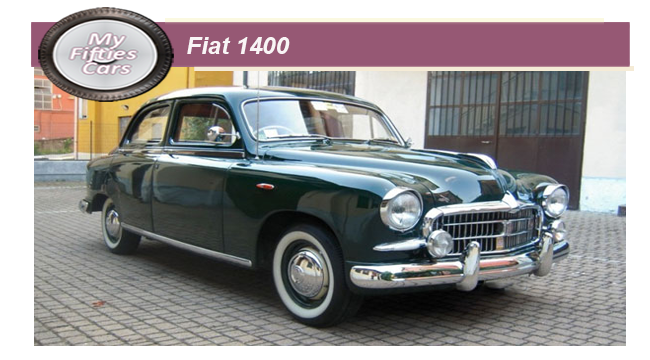 Making its first appearance at the Geneva Motor Show of 1950 the Fiat 1400 was the first example of the new "unibody" style of vehicle to be produced by the Turin, Italy auto giant.
Making its first appearance at the Geneva Motor Show of 1950 the Fiat 1400 was the first example of the new "unibody" style of vehicle to be produced by the Turin, Italy auto giant.
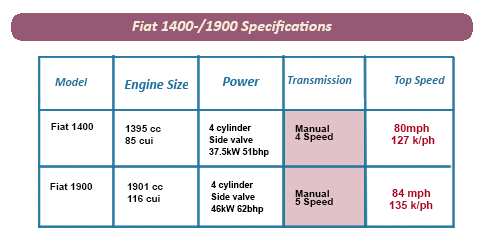 Released as either a sedan or cabriolet (convertible), the 1400 stood out from its mostly pre-Second World War predecessors thanks to its rounded boxier profile, built-in headlamps and a wide grille with horizontal bars and thin vertical dividers.
Released as either a sedan or cabriolet (convertible), the 1400 stood out from its mostly pre-Second World War predecessors thanks to its rounded boxier profile, built-in headlamps and a wide grille with horizontal bars and thin vertical dividers.
Another first for the 1400 came in 1953 with the introduction of a diesel version of the model, imaginatively titled the Fiat 1400 Diesel.
As a response to market demand for a more powerful version of the 1400, saloon, in 1953 Fiat launched the 1900.
The Fiat 1900 used the same body and chassis as the 1400 but came with a 1.9-litre engine as well as a few more luxury refinements, including a distinctive egg-crate grille.
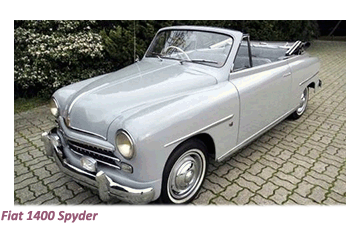 Available only with a petrol engine, the 1900 could generate up to 70 bhp and reach a top speed of 135k.ph (84 mph)
Available only with a petrol engine, the 1900 could generate up to 70 bhp and reach a top speed of 135k.ph (84 mph)
 Not only was the 1900 more powerful but reportedly a much more comfortable ride thanks to its a hydraulically operated clutch and five-speed column shifted manual transmission, which was well ahead of its time.
Not only was the 1900 more powerful but reportedly a much more comfortable ride thanks to its a hydraulically operated clutch and five-speed column shifted manual transmission, which was well ahead of its time.
Among the luxurious features that came as standard on the 1400 and 1900 included armrests built into the doors, a handbrake sited under the dashboard, a "radio receiver: and even a cigar lighter.
![]()
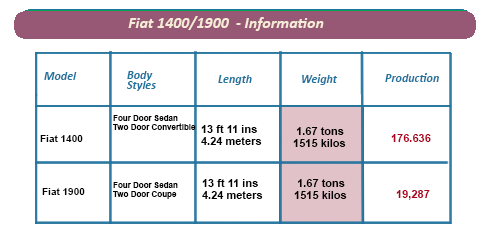 While the convertible version was indeed an eye-pleaser in the 1400 version, the Sedan proved to be a better seller.
While the convertible version was indeed an eye-pleaser in the 1400 version, the Sedan proved to be a better seller.
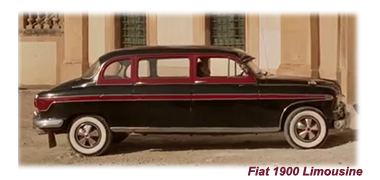 Capable of sitting four passengers comfortably, and six at a squeeze, fitted with a generous trunk, the 1400's 395-cc four-cylinder engine, with aluminium head was capable of generating 45 bhp and, under the right circumstances, hit a top speed of around 125 k/ph ( 78 mph)
Capable of sitting four passengers comfortably, and six at a squeeze, fitted with a generous trunk, the 1400's 395-cc four-cylinder engine, with aluminium head was capable of generating 45 bhp and, under the right circumstances, hit a top speed of around 125 k/ph ( 78 mph)
What might have been important in those still austere time in Italy, was that, despite its size, the 1400 could deliver 22 miles per gallon.
While the Italian public had to make do with the saloon and convertible version of the 1400, with the 1900, Fiat also offered a two-seat coupe which could be designed and constructed according to the customer's specification.
 While most of these fastback bodies were built by Fiat, some of the coupe bodies were created by the highly rated Italian coachwork designers Ghia and Zagato who were more used to working with Ferrari and companies of a similar status.
While most of these fastback bodies were built by Fiat, some of the coupe bodies were created by the highly rated Italian coachwork designers Ghia and Zagato who were more used to working with Ferrari and companies of a similar status.
In the opinion of many from the motoring world of the Fifties, the most exciting version of the Fiat 1900 coupe was an impressive aerodynamic conception from an up and coming independent designer known merely as Rappi.
Unfortunately, the Rappi 1900 coupe barely went into production, and there are no examples around today.
![]()
Production of the 1400 and 1900 in its various formats continued through the Fifties, although the saloon version, which was the backbone of the series, while practical in the extreme, was just too much of a workhorse to fully capture the imagination of the Italian public.
Fiat tried, and almost succeeded in creating more interest in 1400, in 1954 introducing the 1400A sedan which had a larger rear window and modified parking lights.
Two years later, the 1400B version was launched, without too much panache, as the only difference was that the new model only differed from its predecessor by having a set of fog lamps installed in the centre of its grille.
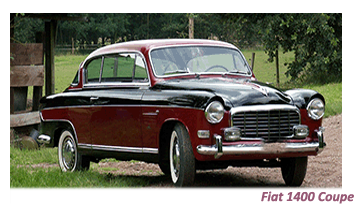 The Fiat 1400 was also the first of many Fiats to be produced under license with an identical Seat 1400 released in Spain and throughout the Iberian peninsula in 1953.
The Fiat 1400 was also the first of many Fiats to be produced under license with an identical Seat 1400 released in Spain and throughout the Iberian peninsula in 1953.
 The Seat 1400 was the first model ever built by the Barcelona-based company at the firm's new plant in the city's Zona Franca zone
The Seat 1400 was the first model ever built by the Barcelona-based company at the firm's new plant in the city's Zona Franca zone
Taken out of production in 1961 to be replaced by the 1500, during its ten-year production run, just under 180,000 versions of the saloon and convertible versions of the Fiat 1400 were produced, with a further 19,000 versions of the1900 released during the same time frame.
Got a question, a comment, a suggestion or an offer??? - FEEL FREE TO CONTACT US ANYTIME!!
Take me back to the Home Page
A guide to acquiring, restoring and maintaining UK or European Classic Cars of the Fifties and Sixties- as well as a recollection of the iconic cars of the era and the visionaries that produced them.
EU6
